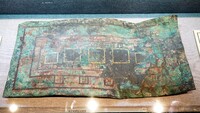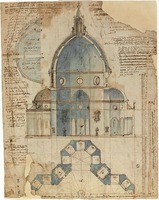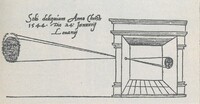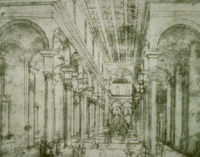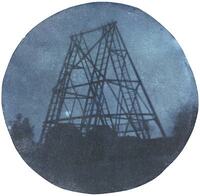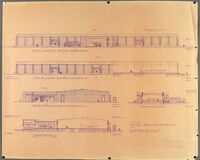
Exhibit curated by Steve Wang
Keywords: Architecture, Cyanotype, Camera Obscura
The use of diagrams in architecture represents a long and evolving history. Architectural drawings are visual representations of building designs that help architects and construction workers to execute their projects. From ancient engravings to Renaissance prints and then to modern CAD (Computer-aided design), architectural diagrams evolve with time, reflecting the changes in technology, design philosophy, and the role of architects.
The history of architectural planning is much longer than people believed. In 1983, archaeologists in China discovered a copper plate in an ancient grave from 200 B.C. This is a copper plate that has been overturned and crushed. 2,300 years of time gives it mottled marks, yet the gold and silver inlaid lines are still readable. This is the oldest known architectural plan, designing the mausoleum of a king. The name is 错金银铜版兆域图(Architectural Plan of Mausoleum Layout on Bronze Plate with Details in Gold and Silver). The king put the ideal blueprint on his territory, facing south, creating a central axis symmetrical palace-style building. The plan is 96 cm long and 48 cm wide. The picture shows the area of the royal mausoleum, the buildings on the mausoleum, the area of each palace and the plane shape. It is marked with two units of measurement, "foot" and "step". The buildings marked with a ruler are drawn strictly according to the scale, with a ratio of 1 to 500.
Now, let’s fast forward a bit to the Medieval ages. Before blueprints evolved into their modern form, drawings from the Middle Ages appeared to be their earliest forms on paper and canvas. The Plan of St. Gall is one of the oldest known surviving architectural plans on paper. The monastery of St. Gall in Switzerland was founded in 719 and still exists today. This collection is a group of manuscripts known to have been held in the St. Gall Library in the ninth century. Also included in this collection are manuscripts from the same period held in the nearby monastery of Reichenau. Analysis of extant monastic library catalogs and study of the hands of known scribes has made it possible to identify approximately seventy extant manuscripts that can be placed with certainty at these two monasteries in the course of the ninth century.
Then it’s the Renaissance. Documents that emerged from the Renaissance era look more like modern blueprints than the ones from the Medical Period. Architects started to use camera obscura to assist in drawing. Filippo Brunelleschi, the designer of the Santa Maria del Fiore Cathedral in Florence, devised the method of perspective for architectural purposes. He made a ground plan for the Church of Santo Spirito in Florence (1434–82), on the basis of which he produced a perspective drawing to show his clients how it would look after it was built.
Until the mid-19th century, architects relied on skilled draftsmen to faithfully copy or enlarge their drawings for distribution. A lot of specialized tools like the parallel straightedge and adjustable triangles were invented for this type of work. Things changed when John Herschel discovered the cyanotype process in the 1830s. Using the cyanotype process, an architectural drawing was made on a semi-transparent paper, then weighted down on top of a sheet of paper or cloth that was coated with a photosensitive chemical mixture of potassium ferricyanide and ferric ammonium citrate. Then, when the document was exposed to light, the background became blue because of the exposure, while the drawing lines blocked the coated paper from exposure and remained white.
Dozens of years later, the diazo process quickly replaced the cyanotype and became the dominant printing process. A lot of other processes and print methods were also invented, such as the Van Dyke prints, mimeographs, hectographs, etc, until the end of the 20th century when computer-aided drafting(CAD) was invented. Combined with large-format printers, the process of drawing, printing, and reproduction became easier than ever.
The history of using diagrams in architecture is a reflection of the technological advancements, cultural shifts, and evolving philosophies within the field. Still, technology is evolving. The revolutionary software might be groundbreaking today but outdated tomorrow. The recent discovery of ancient rock engravings for the desert kite in Saudi Arabia and Jordan, potentially the oldest known architectural plans, underscores that our understanding of this history is still evolving. As technology advances, so too will the methods architects use to conceptualize and construct the environments that shape our world, continuing the rich and dynamic legacy of architectural diagrams.
